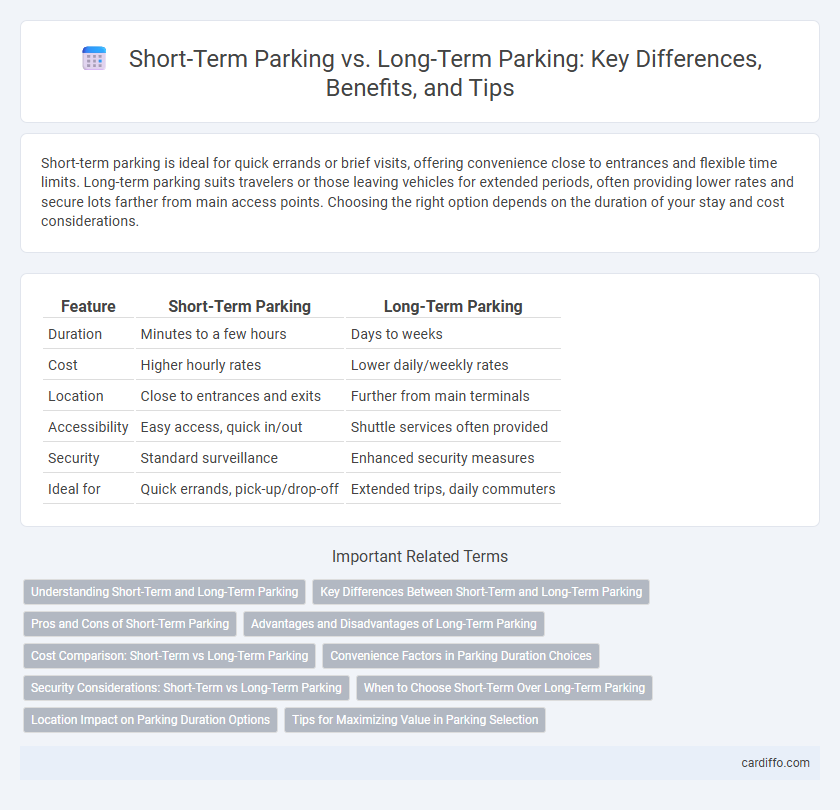Short-term parking is ideal for quick errands or brief visits, offering convenience close to entrances and flexible time limits. Long-term parking suits travelers or those leaving vehicles for extended periods, often providing lower rates and secure lots farther from main access points. Choosing the right option depends on the duration of your stay and cost considerations.
Table of Comparison
| Feature | Short-Term Parking | Long-Term Parking |
|---|---|---|
| Duration | Minutes to a few hours | Days to weeks |
| Cost | Higher hourly rates | Lower daily/weekly rates |
| Location | Close to entrances and exits | Further from main terminals |
| Accessibility | Easy access, quick in/out | Shuttle services often provided |
| Security | Standard surveillance | Enhanced security measures |
| Ideal for | Quick errands, pick-up/drop-off | Extended trips, daily commuters |
Understanding Short-Term and Long-Term Parking
Short-term parking is designed for brief stays, typically ranging from a few minutes to a couple of hours, ideal for quick errands or drop-offs. Long-term parking accommodates vehicles for extended periods, often days or weeks, and is commonly used at airports or transit hubs. Pricing and location vary significantly, with short-term parking generally closer to entrances and more expensive per hour, while long-term parking offers economical daily rates but requires a longer walk or shuttle service.
Key Differences Between Short-Term and Long-Term Parking
Short-term parking caters to stays usually under 24 hours, ideal for quick errands, drop-offs, or airport terminals, often charging higher hourly rates to maximize turnover. Long-term parking accommodates vehicles for extended periods, like several days to weeks, offering lower rates designed for travelers or commuters requiring secure and economical options. Key differences include pricing structures, location proximity to destinations, and intended duration, making short-term optimal for convenience and long-term cost-efficiency.
Pros and Cons of Short-Term Parking
Short-term parking offers quick and convenient access near entrances, ideal for errands or brief visits, but typically costs more per hour compared to long-term options. Its primary advantage is flexibility, allowing easy vehicle retrieval without extended commitments. However, the premium pricing and limited availability during peak times can be major drawbacks for extended stays.
Advantages and Disadvantages of Long-Term Parking
Long-term parking offers cost-effective solutions for travelers needing extended vehicle storage, often featuring lower daily rates compared to short-term options. However, the distance from terminals and less frequent shuttle services can result in inconvenience and longer transit times. Security measures vary, and while some long-term lots provide robust surveillance, others may pose risks due to limited monitoring.
Cost Comparison: Short-Term vs Long-Term Parking
Short-term parking typically incurs higher hourly rates, making it cost-effective only for brief stays or quick errands. Long-term parking offers significantly lower daily or weekly rates, ideal for extended trips or multi-day stays. Comparing average costs reveals short-term parking can be up to three times more expensive per day than long-term options.
Convenience Factors in Parking Duration Choices
Short-term parking offers maximum convenience for quick errands or brief visits, allowing easy access and flexible payment options to accommodate short stays. Long-term parking prioritizes cost efficiency and security for extended durations, often featuring reserved spots and shuttle services to terminals. The choice between short-term and long-term parking depends on balancing convenience, duration, and budget needs.
Security Considerations: Short-Term vs Long-Term Parking
Short-term parking typically offers enhanced security features such as frequent patrols, surveillance cameras, and easy access to staffed entry points, reducing the risk of theft or vandalism. Long-term parking areas may have fewer security measures and less frequent monitoring, making vehicles more vulnerable over extended periods. Choosing parking with robust security systems like gated access and 24/7 video monitoring is crucial for safeguarding vehicles in both short-term and long-term scenarios.
When to Choose Short-Term Over Long-Term Parking
Short-term parking is ideal for quick errands, airport drop-offs, or brief visits under a few hours, providing easy access and convenience near entrances. Choose short-term parking when duration does not exceed four hours to avoid high fees and maximize flexibility. For stays longer than a day, long-term parking is more cost-effective and often includes shuttle services to terminals or main venues.
Location Impact on Parking Duration Options
Short-term parking is often situated closer to building entrances or high-traffic areas, providing convenience for brief stays and quick access. Long-term parking lots tend to be located farther from main facilities, offering more affordable rates for extended durations but requiring additional transit options such as shuttle services. The proximity of parking spaces directly influences the preferred parking duration, balancing accessibility with cost-effectiveness.
Tips for Maximizing Value in Parking Selection
Choosing between short-term and long-term parking depends on your trip duration and budget, with short-term parking ideal for quick errands and long-term parking offering cost savings for extended stays. Look for parking facilities near your destination that provide daily or monthly rates, and consider off-site locations with shuttle services to airports or city centers to maximize convenience and reduce costs. Utilize apps and booking platforms to compare prices, reserve spots in advance, and take advantage of discounts or loyalty programs to get the best value in parking selection.
Short-term parking vs long-term parking Infographic

 cardiffo.com
cardiffo.com